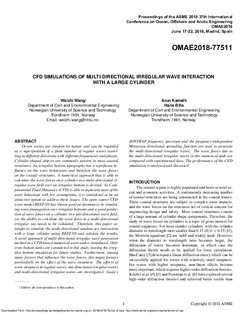| dc.contributor.author | Wang, Weizhi | |
| dc.contributor.author | Kamath, Arun | |
| dc.contributor.author | Bihs, Hans | |
| dc.date.accessioned | 2018-10-18T11:12:03Z | |
| dc.date.available | 2018-10-18T11:12:03Z | |
| dc.date.created | 2018-09-28T08:57:52Z | |
| dc.date.issued | 2018 | |
| dc.identifier.isbn | 978-0-7918-5121-0 | |
| dc.identifier.uri | http://hdl.handle.net/11250/2568634 | |
| dc.description.abstract | Ocean waves are random by nature and can be regarded as a superposition of a finite number of regular waves travelling in different directions with different frequencies and phases. Cylinder-shaped objects are commonly present in most coastal structures. An irregular bottom topography has a significant influence on the wave behaviours and therefore the wave forces on the coastal structures. A numerical approach that is able to calculate the wave forces on a cylinder in a multi-directional irregular wave field over an irregular bottom is desired. As Computational Fluid Dynamics (CFD) is able to represent most of the wave behaviour with few assumptions, it is considered to be an attractive option to address these issues. The open-source CFD wave model REEF3D has shown good performances in simulating wave propagation over irregular bottoms and a good prediction of wave forces on a cylinder in a uni-directional wave field, yet the ability to calculate the wave force in a multi-directional irregular sea needs to be validated. Therefore, this paper attempts to simulate the multi-directional random sea interaction with a large cylinder using REEF3D and validate the results. A novel approach of multi-directional irregular wave generation method in a CFD-based numerical wave tank is introduced. Only even-bottom tanks are considered in this study, leaving the irregular bottom simulation for future studies. Furthermore, among many factors that influence the wave forces, this paper focuses particularly on the effect of the wave steepness. The effects of wave steepness in regular waves, uni-directional irregular waves and multi-directional irregular waves are investigated. Goda’s JONSWAP frequency spectrum and the frequency-independent Mitsuyasu directional spreading function are used to generate the multi-directional irregular waves. The wave forces due to the multi-directional irregular waves in the numerical tank are compared with experimental data. The performance of the CFD simulation is analysed and discussed. | nb_NO |
| dc.language.iso | eng | nb_NO |
| dc.publisher | American Society of Mechanical Engineers (ASME) | nb_NO |
| dc.relation.ispartof | ASME 2018 37th International Conference on Ocean, Offshore and Arctic Engineering - Volume 2: CFD and FSI | |
| dc.title | CFD Simulations of Multi-Directional Irregular Wave Interaction With a Large Cylinder | nb_NO |
| dc.title.alternative | CFD Simulations of Multi-Directional Irregular Wave Interaction With a Large Cylinder | nb_NO |
| dc.type | Chapter | nb_NO |
| dc.description.version | publishedVersion | nb_NO |
| dc.identifier.doi | 10.1115/OMAE2018-77511 | |
| dc.identifier.cristin | 1615420 | |
| dc.relation.project | Statens Vegvesen: 90121200 | nb_NO |
| dc.description.localcode | (c) 2018 by ASME | nb_NO |
| cristin.unitcode | 194,64,91,0 | |
| cristin.unitname | Institutt for bygg- og miljøteknikk | |
| cristin.ispublished | true | |
| cristin.fulltext | preprint | |
| cristin.qualitycode | 1 | |
